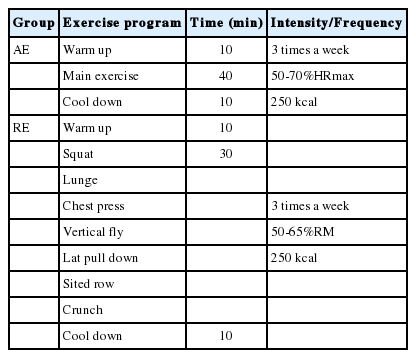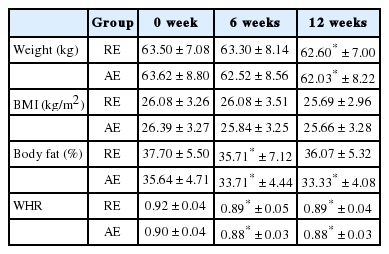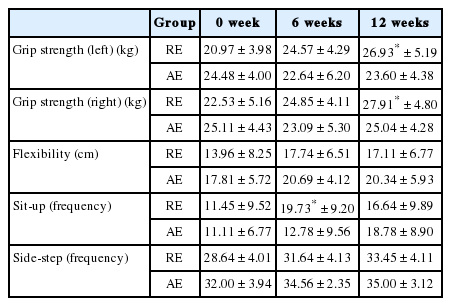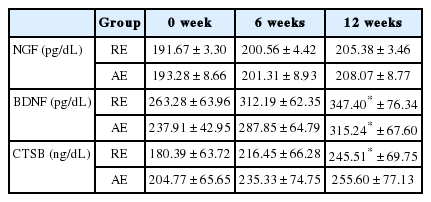운동형태가 비만 중년여성들의 Myokine 인자들에 미치는 영향
Effects of Myokine Factors on Exercise Types in Obese Women
Article information
Trans Abstract
PURPOSE
This study was to investigate that the effects of aerobic and resistance exercise on the improvement of metabolic hypertension by analyzing their body composition, basal fitness, and myokine factors in obese middle women.
METHODS
The subjects were living in C city and body fat of over 30%. These were divided into the aerobic exercise group (n=9) and the resistance exercise group (n=12) by random sampling. All the contents of the study were approved by K University IRB and applied to the guidelines for personal safety.
RESULTS
The subjects were living in C city and body fat of over 30%. These were divided into the aerobic exercise group (n=9) and the resistance exercise group (n=12) by random sampling. All the contents of the study were approved by K University IRB (KWNUIRB-2016-04-009-002) and applied to the guidelines for personal safety.
CONCLUSIONS
These results suggest that resistance exercise is more effective for muscle strength and myokine factors than aerobic exercise. Therefore, it is suggested that resistance exercise is more effective exercise to improve serum BDNF and CTSB levels due to more muscle contraction activity than aerobic exercise.
서 론
나이가 들어감에 따라 노화 현상은 근 감소증의 원인이다. 이러한 노화현상은 체중과 체지방을 증가시켜 신체구성의 부정적 변화로 비만 발생비율을 증가시키게 된다[1]. 이처럼 비만을 동반하는 노화 현상은 근 감소증과 신체기능 저하를 더욱 악화시키는 것으로 나타난다[2]. 노화가 진행되는 여성들은 건강한 상태를 희망하여 식이섭취 감소에 의한 체중과 체지방의 감소를 열망하지만, 마른 비만에 대한 인식 부족으로 신체활동량은 감소하고 식이조절에만 의존하여 근육과 안정시 에너지 소비 감소로 나타난다[3]. 중년 또는 노인들의 경우 오랜 기간 동안의 좌식 생활로 인해 제2형 당뇨병과 심혈관질환의 증가에 노출되어 있으며, 정상인보다 이른 죽음을 맞이하게 된다[4-7]. 이러한 좌식생활에 의한 운동부족 또는 비활동성은 만성적 질병 또는 다양한 질병 노출의 원인이다[8]. 반면 많은 연구들에서 신체활동은 비만을 감소시켜주며, 특히 중강도 규칙적인 운동은 체중감소와 지방 감소에 필수적임을 증명하였다[9-12].
골격근은 체중의 40%를 차지하는 신체에서 가장 큰 기관으로 특히 여성들에게 있어 근력 향상은 필수적이다. 이러한 골격근은 최근 내분비 기관으로 인식하여 골격근으로부터 분비되는 단백질을 마이오카인(myokine)이라 명명하였다[13]. 최근까지 새롭게 발견된 myokine 인자들은 약 50개 정도이며, 인체의 근관세포와 단백질체 가까운 곳에서 발생된다[14-16]. 근육에서 도출되는 myokine은 운동과 관련된 대사변화뿐만 아니라 트레이닝에 적응하는 대사변화를 중재하는 역할을 한다[17]. 특히 근수축에 반응하는 myokine 분비는 장·단기적으로 다양한 대사 조절자로 보여지며[18], 골격근과 다른 기관 사이 운동 후와 운동 중에 직간접적으로 지방조직에 효과적인 것으로 알려져 있다[19].
한편, 신체활동은 뇌기능 향상을 포함하는 건강에 도움이 된다[20]. 특히 규칙적인 운동은 인지기능의 향상과 유지에 효과적이다[21]. 설치동물에서 달리기 운동은 뇌 신경전달물질, 신경영양인자 수준, 뉴런형태학, 그리고 혈관신생의 변화를 유도하고, 기억과 신경성장을 강화시킨다[20]. 인간에서는 유산소운동 능력과 해마 가소성 그리고 기억력에 관련이 있다[21]. 하지만 여전히 운동의 긍정적인 효과에 대한 말초 기전에 대한 의문점은 남아있다.
최근 말초 혈중 인자들은 실험 동물의 뇌 가소성을 향상시키는 것으로 나타났다[22]. 골격근은 운동에 중심축 역할을 하며[23], myokine 인자들은 신경가소성에 영향을 주는 것으로 보고되고 있다[17]. 최근 cathepsin B (CTSB) 수준은 기억 기능과 관련하여 운동에 의해 분비가 촉진되는 것으로 보고되고 있다. CTSB의 억제는 해마의 BDNF 발현을 감소시키고[24], 신경세포의 CTSB 처치는 brain-derived neurotrophic factor (BDNF)의 발현에 영향을 주는 것으로 생체내외 분석 결과가 일치하게 나타나 새로운 myokine으로 간주되고 있다[25]. 임상적으로 CTSB의 높은 수준은 다양한 암 환자들에서 발견되고 있으며[26], 정상 생리상태에서 CTSB의 역할은 아직 명확하지 않다. 그러나 실험동물과 인간에서 CTSB는 장기간 트레이닝 후에 혈장에서 증가하는 것으로 나타나, 아직 myokine으로서 CTSB는 논란의 여지가 있다. 하지만 달리기와 같은 운동은 해마 CTSB 유전자 발현을 증가시켰으며, 이것은 운동이 저산소를 유발하여 뇌 CTSB 수준을 증가시킨 것으로 간주하고 있다[27,28]. 또한 운동은 신경 파편을 깨끗하게 정리하고[29], 기억 기능의 증폭 과정으로 신경생성에 도움을 주는 것으로 보고하고 있다[30]. 따라서 본 연구의 목적은 비만 중년여성들을 대상으로 유산소운동과 저항성운동을 각각 실시하여 그들의 신체조성, 기초체력, 그리고 myokine 인자들(NGF, BDNF, CTSB)을 분석하여 운동형태에 따른 대사 항진 개선에 대한 효과를 규명하고자 한다.
연구 방법
1. 연구 대상
본 연구의 대상자는 C시에 거주하고 있으며, 의학적 질병이 없는 체지방률 30% 이상인 비만 성인여성들(n=21)을 대상으로 무작위추출법에 의해 유산소운동그룹(n =9)과 저항성운동그룹(n =12)으로 분류하였다. 12주 동안 주 3회 일일 250 kcal (PLOAR M400, POLAR Co., UAE)를 소비하는 운동을 실시하였으며, 모든 대상자들에게 연구의 목적을 설명하고, 동의서를 작성한 뒤 K대학 임상시험심사위원회의 승인을 얻어 개인의 안전보장은 물론 권리 등에 대한 지침을 적용하여 실시하였다. 대상자들의 일반적 특성은 Table 1과 같다.
2. 실험방법
1) 신체구성 및 기초체력 검사
신체조성 검사는 체성분분석기(Inbody 720, bio space, Korea)를 통해 신장, 체중, 체질량지수, %fat, WHR을 측정하였다. 기초체력검사는 O2run사의 체력증진시스템을 이용하여 근력(악력, 배근력), 근지구력(윗몸일으키기), 민첩성(사이드스텝), 순발력(서전트 점프), 유연성(앉아 앞으로 굽히기)을 측정하였다.
2) 혈액검사
채혈은 전완정맥에서 헤파린 처리된 tube에 담아 3,000 rpm으로 원심분리하여 혈청성분을 추출하여 즉시 -80˚C에 보관한 뒤 분석하였다. 분석방법은 ELISA 방식을 이용하여 NGF (R&D system, DY256), BDNF (R&D system, DY248), CTSB (R&D system, DY953)를 분석하였다.
3) 운동 프로그램
유산소운동프로그램은 주 3회, 일일 60분 동안 운동강도 50-70% HRmax로 polar (M400)를 이용하여 250 kcal를 소비하는 운동을 실시하였으며, 저항성운동은 1RM의 50-65%에 해당되는 운동강도로 유산소운동과 동일하게 운동량을 설정하여 실시하였다. 본 연구의 운동프로그램은 Table 2와 같다.
4) 자료처리방법
본 연구에서 얻은 자료는 SPSS PC Windows version 22.0 통계 package를 이용하여 모든 측정항목에 대한 평균과 표준편차를 산출하였다. 모든 변인들은 그룹 간(2)×시기 간(3) 2way ANOVA를 실시하였으며, 그룹과 시기 간에서 각각 유의성이 나타날 경우 독립검증과 Duncan’으로 사후검증을 실시하였다. 모든 통계적 유의수준(α)은 .05로 설정하였다.
연구결과
1. 신체구성의 변화
체중은 0주에 비해 12주 후 두 그룹 모두 유의하게 감소하였다(p<.05). %fat은 두 그룹 모두 0주에 비해 6주 후 유의하게 감소하였으며(p <.05), 유산소 그룹에서 0주에 비해 12주 후 유의하게 감소하였다(p <.05). WHR은 두 그룹 모두 0주에 비해 6주와 12주 후 유의하게 감소하였다(p<.05). 연구대상자들의 신체구성 변화에 대한 결과는 Table 3과 같다.
2. 기초체력의 변화
악력(좌)에서 저항성운동그룹은 0주에 비해 12주 후 유의하게 증가하였다(p<.05). 또한 악력(우)에서 저항성운동그룹은 0주에 비해 12주 후 유의하게 증가하였다(p <.05). 하지만 다른 모든 변인에서는 통계적 유의수준이 나타나지 않았다. 연구 대상자들의 기초체력 변화에 대한 결과는 Table 4와 같다.
논 의
일반적으로 신체활동 또는 규칙적인 운동은 신경가소성의 감소를 예방하고 기억력을 유지하게 한다. 그러나 나이가 증가함에 따라 신체활동이 감소하게 되며, 이는 비만으로 연결되고, 신경가소성의 감소와 더불어 기억력의 쇠퇴를 가져오는 악순환이 되풀이 된다. 또한 비만은 당뇨, 심혈관질환, 고혈압 등 다양한 질병을 동반하는 강력한 위험 요소이다[31]. 최근 미국스포츠의학회에서 주 5회, 하루 30-60분 가량 유산소 운동을 권장하고 있으며, 균형적인 건강상태를 위해서는 저항성운동과 유연성 운동을 포함할 것을 권장하고 있다[32]. 본 연구에서 밝혀진 내용은 비만 여성들의 운동형태에 따른 myokines 농도는 두 운동 모두 긍정적인 효과가 나타났으며, 특히 저항성운동이 더욱 효과적인 것으로 나타났다.
실험동물에서 규칙적인 운동은 해마에서 신경가소성을 중재하는 인자들의 상향 발현을 보고하고 있다[33,34]. 특히 시냅스 가소성의 주요 조절인자인 BDNF는 질병 상태에서는 낮은 수준으로 존재하지만[35], 규칙적인 운동은 해마와 피질 신경에서 BDNF 발현을 상향 조절하여 시냅스 재생성에 효과적인 것으로 보고하고 있다[36]. 또한 규칙적인 운동이 고령 설치류의 기억 기능과 신경생성에 효과적임을 증명하였다[37,38]. 인간 연구에서 역시 규칙적인 운동은 뇌의 관류와 기억력 향상에 효과적인 것으로 보고하고 있다[39,40]. 또한 운동은 해마량이 증가하고 기능이 향상되는 것과 BDNF의 변화와 상관성이 높은 것으로 보고하고 있다[41,42]. 그러나 의학적 질병이 없는 성인들은 3달간의 중고강도 운동 이후 BDNF의 변화가 없는 것으로 나타났다[43]. 또다른 연구 역시 건강한 성인에서 운동은 해마량의 변화에 영향을 주지 못하는 것으로 나타났다[41]. 성인 비만 여성을 대상으로 실시한 본 연구는 두 운동 모두 체중의 변화를 가져왔으며, 특히 지방의 감소에 효과적인 것으로 나타났다. 그리고 뇌신경조절과 관련이 높은 BDNF 수준을 상향 조절하는 결과가 나타났다. 이는 선행연구들이 제시하고 있는 운동의 일반적인 효과와 유사하며, 최근 제시되고 있는 운동으로 인한 지방의 감소가 혈중 myokine 인자로 제시되는 BDNF의 변화를 초래하여 뇌의 관류와 뇌신경가소성에 영향을 주는 것으로 판단된다.
CTSB는 몇 가지 경로를 통해 뇌 기능에 대한 운동의 이득을 중재하는 것으로 나타나 있다. 즉 유산소성 운동은 해마의 회생질량을 증가시키고, 해마의 회색질량은 CTSB와 높은 상관이 있는 것으로 나타났다[21]. 또한, 달리기는 전체 해마 CTSB 유전자 발현을 증가시키며, 달리기는 저산소를 유발하여 뇌 CTSB 수준을 증가시킨다[27,28]. 이는 기억 기능 향상을 위한 신경잔해의 제거와 신경생성 과정으로 볼 수 있다[29,30]. 실험동물에서 운동은 혈장 CTSB 수준을 증가시키고, CTSB가 부족한 실험동물은 공간·지각 능력이 낮은 상태에서 규칙적인 운동중재로 인하여 기억에 효과적인 것으로 보고하였다[25]. 동물연구와 유사하게 인간 연구에서는 CTSB 농도 수준, 체력, 그리고 해마와 관련하여 기억력에 정적인 상관관계가 나타나 신체활동에 따른 CTSB의 관련성을 증명하였다[25]. 본 연구에서 선행연구와 달리 CTSB의 농도 수준은 유산소운동에서 증가하는 경향이 나타났으나 통계적인 유의성은 나타나지 않았으나, 저항성운동은 운동 후 유의하게 증가하는 것으로 나타났다. 이는 유산소성운동에 비해 저항성운동은 근육의 수축과 이완이 더욱 활발하게 작용하여 myokine으로 간주되는 CTSB의 활성에 더욱 효과적임을 암시한다.
결 론
본 연구는 비만 중년여성들을 대상으로 유산소운동과 저항성운동을 각각 실시하여 그들의 신체조성, 기초체력, 그리고 myokine 인자들(NGF, BDNF, CTSB)을 분석하여 다음과 같은 결론을 얻었다. 두 운동군 모두 체중과 체지방률의 유의한 감소를 가져왔다. 그리고 기초체력에서 저항성운동군은 악력과 윗몸일으키기에서 유의한 증가가 나타났다. BDNF 농도 수준은 두 운동군 모두 유의한 증가가 나타났으나, CTSB 농도 수준은 저항성운동군에서만 유의한 증가가 나타났다. 이러한 결과로 볼 때, 유산소운동보다 저항성운동이 근력향상과 myokine 인자들에 더욱 효과적인 것으로 나타났다. 따라서 비만 중년여성들에게 동일한 운동량으로 운동을 할 경우, 유산소운동보다 저항성운동이 더 많은 근수축 활동으로 근력의 증가를 가져오며, 이는 myokine으로 간주되는 혈중 BDNF와 CTSB 농도 수준 향상에 더욱 효율적인 운동임을 시사한다.




